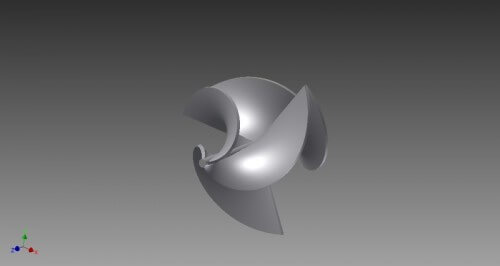The flamingo gave a Spanish biomimicry entrepreneur an idea to build a sea wave turbine
By: Shimon Bogan

"They are waves in the rush of wheels" Rabbi Yehuda Halevi wrote in the poem "On the Sea" (on his way from Spain to Israel via Egypt, in 1140).
Ideas for producing electricity from the energy of the cyclic movement of sea waves have been presented and patents approved since the beginning of the 20th century. In Israel, for example, the writer and playwright Yigal Musinzon (Hasamba, Casablanca) received public funding in 1966 to realize his invention in the field, but abandoned the idea.
The most common and accepted approach is to copy the movement of the waves into a one-dimensional movement - up / down - of a buoy, or forward / backward of a giant hollow wing. A more advanced invention combines the movement in both axes by moving a hollow box that is anchored on leading stationary rods, vertically and horizontally. The linear movements of the proposed facilities are converted by mechanical or pneumatic means into rotary movement of a rotor inside a generator for electricity production.
Is it possible to implement Rihel's law as it is? Is it possible to make the wheel rotate continuously in one direction with the force of the sea waves, without changing direction and without losing energy? Is it possible to give up the box and dispose of it?
Rafael Aparicio Sánchez from Valencia is a biomimicry entrepreneur. His multidisciplinary worldview and his thoughts are best expressed and formulated, in Spanish, On his blog.
The flamingo feeds on plankton at the edges of lakes and ponds. For this purpose, the bird transfers huge amounts of water through its large beak, which serves as a pump and a filter. During three months in which he studied the eating habits of the flamingo, Raphael was guided by a vague gut feeling that in the way the head moves from the feet forward, and in the tiny waves that are created during the movement of the unique beak, there is more than meets the eye.
To watch a video on the subject:
In his fevered mind the design of the source, the small waves and the knowledge that there was an engineering problem in the capture of wave energy came together. In an inverted way of thinking, and as a staunch follower of the reverse engineering process, Raphael decided to use engineering methods and tools to examine the effect of waves in water on the movement behavior of a flamingo beak model, and the hydrodynamic characteristics of such an assembly.
The in-depth and multidisciplinary investigation resulted in a wheel with an unusual and special design - three wings in the shape of a flamingo's beak on the circumference. The wide end of each wing is pushed by the movement of the wave in the sea, while the narrow end plows and cuts the current in its counter-rotating motion. In this way, the movement in the return does not produce a significant resistance to the rotation. The wide end of the wings was upgraded several times until a laminar flow profile was achieved, and the deceleration due to turbulence drag was reduced to a negligible minimum. This behavior takes place in the back-and-forth and up-down movement of the sea waves. This is how a flywheel was obtained, which performs a rapid continuous unidirectional rotation. The way from such a wheel, which is inspired by the origin of the flamingo, and works, to produce electricity - is familiar and standard.

One response
A. I don't see any resemblance of the turbine to the original flamingo.
B. In wave motion there is not much energy. Tidal flow is usually used.
third. The flow in wave motion is only in shallow water, and there it is difficult to separate back and forth motion. In depth the movement is up and down, and there is a minimum of horizontal movement.
d. The use of a flywheel is unnecessary and it is a waste of components.
God. Preventing the turbine from turning the other way when the wave returns causes the loss of half of the available energy.
So probably the expression "drilled mind" is indeed appropriate here.
And a question: Did Yigal Musinzon receive funding for the development of his invention to create energy from the movement of waves or for the development of his invention to create energy by detonating explosives in a large pit in the ground and using the heat generated? Private or government funding? (To his credit - he had a rich imagination and I really enjoyed the Hasambah books he wrote).